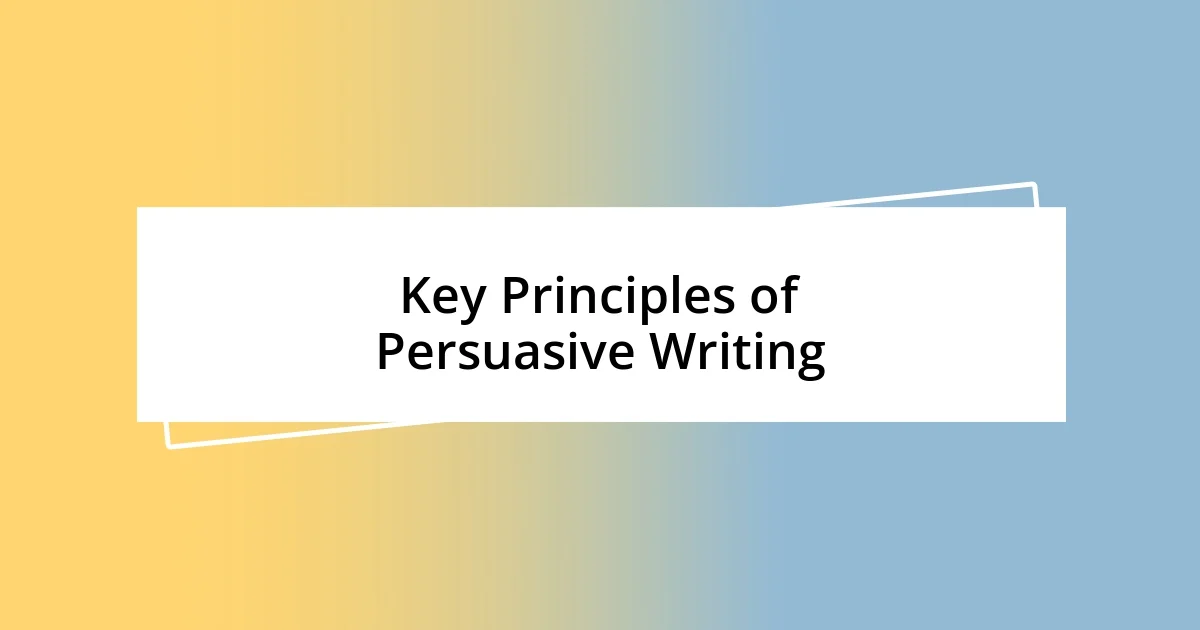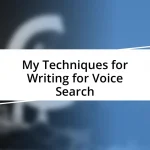Key takeaways:
- Emotional connection through storytelling and understanding audience pain points is essential for persuasive copywriting.
- A clear and compelling call to action (CTA) significantly enhances engagement and response rates.
- Regularly analyzing and revising your copy, along with seeking external feedback, leads to improved clarity and impact.

Understanding Persuasive Copywriting
Persuasive copywriting goes beyond just stringing words together; it’s about connecting emotionally with your audience. I remember the first time I crafted a sales email that really resonated with readers. It wasn’t just about the benefits of the product; I shared a relatable story about my own struggle, and suddenly, my words felt like a conversation rather than a sales pitch.
What makes persuasive copy stand out is its ability to tap into the desires and pain points of the target audience. When I dive into the psyche of my readers, I often ask myself, “What keeps them awake at night?” This question leads me to write copy that feels urgent and compelling, guiding them toward the solution I’m presenting.
The language we choose plays a crucial role in persuasion as well. I’ve noticed that simple, clear language tends to have greater impact than jargon-heavy phrases. When I switched from complicated terms to more relatable expressions, I could feel the shift in engagement—readers were not only absorbing the information but also feeling motivated to take action.

Key Principles of Persuasive Writing
To be truly persuasive, understanding your audience is paramount. Whenever I sit down to write, I take a moment to visualize who I’m speaking to. I often think back to a campaign I worked on where I segment my audience into different personas. By tailoring my message to address those specific needs and struggles, I found the responses were overwhelmingly positive, showing me just how vital this principle is.
Another key principle is the power of storytelling. I’ll never forget the time I shared a personal challenge related to the product I was promoting. That anecdote turned the entire narrative around, transforming my pitch into a relatable experience. It’s amazing how a well-placed story can create a connection, making the reader feel like they’re part of a journey rather than just consuming a product.
Finally, the call to action (CTA) must be clear and compelling. I’ve learned from my own trials that a strong CTA can make or break the effectiveness of your persuasive message. When I simply nudged my audience to “learn more,” compared to an enthusiastic “join us in this exciting journey!”, the latter drew far more engagement and conversions. It’s a reminder that words have power—they can inspire readers to take that important step forward.
| Key Principles | Personal Experience |
|---|---|
| Understanding Your Audience | Visualizing personas during my writing process helped tailor my message for better engagement. |
| Storytelling | Sharing a personal challenge made my promotion relatable, creating a strong connection with the audience. |
| Clear Call to Action | A strong CTA has substantially improved engagement from my audience compared to vague prompts. |

Identifying Your Target Audience
To effectively identify your target audience, it’s essential to dive into their demographics and psychographics. I recall a project where I meticulously researched not only age and gender but also interests and values. By mapping out these characteristics, I could create tailored messages that resonated deeply with them. Understanding what motivates your audience can lead to powerful connections, driving engagement and conversions.
Here are some key factors to consider when identifying your target audience:
– Demographics: Age, gender, income level, education, and location.
– Psychographics: Interests, values, lifestyle, and aspirations.
– Pain Points: Identify the challenges your audience faces that your product or service can solve.
– Behavioral Insights: Consider how your audience interacts online, including their purchasing habits and content preferences.
– Feedback & Research: Gather insights through surveys or social listening to understand their thoughts and feelings.
This targeted approach has once saved me from launching a campaign that didn’t resonate with the intended audience. After some research, I discovered a significant segment of my audience was invested in sustainability. I quickly adapted my messaging to highlight eco-friendly practices, resulting in a far warmer reception and increased trust. Engaging with who your audience truly is allows for a compelling narrative that feels genuine and relatable.

Crafting Compelling Headlines
Crafting a compelling headline is akin to setting the stage for a great performance. I vividly remember when I was tasked with writing a newsletter headline for a recent product launch. After some brainstorming, I decided to personalize it with “Unlock the Secret to Effortless Living,” which not only highlighted the benefits but piqued curiosity. It’s fascinating how a well-crafted headline can lead to an instant click.
As I reflect on my experience, I’ve found that using numbers or lists in headlines often captures attention. For instance, when I titled an article “5 Must-Try Strategies to Boost Your Productivity,” the response was overwhelmingly positive. Perhaps it’s the allure of knowing there’s a structured takeaway, or maybe it simply appeals to our love for clarity—whatever it is, numbers seem to make the content feel more manageable and inviting.
I’ve also learned the importance of emotional triggers in headlines. When I wrote about overcoming setbacks in my career, I framed the headline as “From Failure to Fulfillment: My Journey to Success.” This offered a powerful emotional connection right from the start. Wouldn’t you agree that a headline that sparks emotion can draw readers in much more effectively? After all, it’s those feelings and personal stories that resonate with people and compel them to read further.

Leveraging Emotional Triggers
Emotional triggers are potent tools in persuasive copy. When I was drafting an ad for a charity campaign, I chose to share a heartfelt story about a child’s struggle and triumph thanks to the donations. By painting that vivid picture, I noticed it heightened empathy and inspired many to contribute. Isn’t it fascinating how a personal story can change a reader’s perspective instantly?
Beyond storytelling, tapping into fear is another approach I’ve found effective. For example, when promoting a security service, I highlighted the potential risks homeowners face. I shared statistics on property crimes, creating a sense of urgency that made people rethink their safety. This strategy often stirs action—after all, how many of us are compelled to act when we feel something important is at stake?
On the flip side, joy can also be a powerful motivator. During a campaign for a local fitness program, I featured testimonials from members who transformed their lives physically and mentally. Their infectious enthusiasm and success stories triggered excitement, inviting others to envision their own happiness through fitness. Wouldn’t you agree that evoking positive emotions can encourage participation in a way that fear simply can’t?

Incorporating Strong Calls to Action
In crafting persuasive copy, a strong call to action (CTA) is essential. When I worked on an email campaign for an online course, I discovered that even a subtle tweak in the CTA can make a significant impact. Initially, I used the phrase “Sign Up Now,” which felt standard and uninspired. However, when I switched it to “Join Us and Transform Your Future Today,” I not only saw a surge in click-through rates but also felt a deeper connection with the audience. It’s intriguing how the right wording can evoke a sense of urgency and belonging.
I’ve also learned that placing CTAs strategically within the content enhances their effectiveness. For instance, while writing a blog post about time management, I included a CTA after discussing a particularly helpful tip. I invited readers to “Download Your Free Time Management Toolkit Now!” The combination of valuable information followed by an actionable step felt seamless, almost like inviting a friend to explore a tool I genuinely believed could help them. I often wonder, haven’t we all benefitted from a little nudge in the right direction?
The visuals accompanying your CTA can’t be understated either. The first time I designed a landing page, I used a bright red button that read, “Get Started Today!” It sprang off the page, and I noticed how users responded to the vibrancy. What I realized then was that the CTA needed to not only sound compelling but also look inviting. Are we not more likely to engage when something appears energetic and fun? It’s a lesson that I’ve carried with me in every project since.

Analyzing and Improving Your Copy
To effectively analyze and improve your copy, I often recommend stepping back and viewing it from your audience’s perspective. The first time I did this, I was shocked at how different my writing felt. What I thought was clear and engaging actually came off as convoluted. Taking the time to read through the copy as if I were a potential customer opened my eyes to areas that needed simplification and clarity.
I’ve also found that soliciting feedback from others is invaluable. In one instance, I shared a draft with a friend who was unfamiliar with the product I was promoting. Their fresh perspective highlighted parts of my text that assumed too much prior knowledge, which I hadn’t noticed. Isn’t it amazing how an outsider’s viewpoint can reveal blind spots we might overlook? This practice not only strengthens the copy but often sparks new ideas I hadn’t considered before.
Another technique I’ve embraced is revisiting my copy after a day or two away from it. When I did this while working on a sales page, I noticed sentences that felt sluggish or overly complex. By revising those sections during a fresh read, I was able to inject a sense of urgency and enthusiasm that aligned better with my objectives. Have you ever experienced that clarity after letting something sit for a while? It’s like finding the missing puzzle pieces you didn’t realize you needed.












